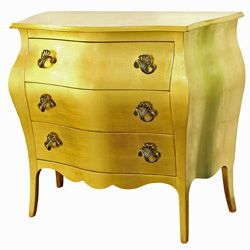Bed bugs are hard to identify, but they aren't invisible. They leave signs you can sometimes detect if you're careful and observant. If you find an item from a reputable seller you think is worth serious consideration, grab a magnifying glass and flashlight and look for these telltale signs of bed bug activity:
- Bed bugs deposit small black spots after feeding. You can sometimes see groups of pinpoint spots on hard and soft surfaces. Fabrics may also show reddish streaks or smears.
- Since bed bugs spend a lot of time hiding, check the backs and undersides of tables, shelves, headboards and other furnishings for live bugs or molted skins (discarded bed bug exoskeletons).
- Bed bugs often hide inside furniture joints, seams, creases, crevices, cracks and voids. You can sometimes also find them or their eggs in screw holes, nail holes and small louvered vents. Shine a flashlight into narrow openings and inspect them with a magnifying glass. You may even catch a bed bug scurrying away from the light.
- If you're interested in a painted furniture piece, check for bed bugs hiding under any loose paint. Yes, they can hide behind peeling, soft or uneven painted surfaces as well as behind wallpaper.
- Bed bugs sometimes gather behind the paper backing on framed prints, too.
These are just a few places bed bugs hide. There are many, many more. Bed bugs can shelter inside hollow towel racks and curtain rods as well as in small appliances. They can burrow into plush toys. They can conceal themselves in clothing, bedding, curtains, rugs, shoes, handbags and just about anything else you can imagine.
After you invest in a secondhand piece of furniture, consider heat treating it in a dark plastic bag to be sure it doesn't harbor bed bugs or their eggs. (Remember, your target is at least 110 degrees Fahrenheit for three hours or more.) If that's not feasible given the size of the object, place it in quarantine in an empty bathtub. Bed bugs can't escape up the slippery sides of tubs, so they'll be contained and easier to detect. Barring all other options, keep new acquisitions away from sleeping areas and inspect them periodically for bed bug activity like spots, exoskeletons and eggs.


